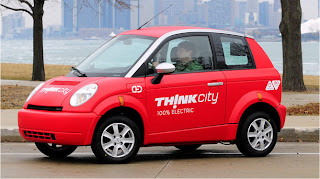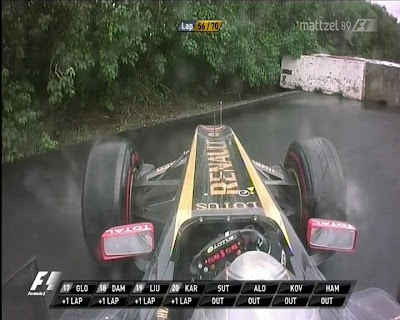So Think Global, manufacturer of quirky plastic electric city cars has filed for bankruptcy and ceased all international operations. Yet another car maker bites the dust, in the face of a hostile economic climate and lack of continuing investment. Not a surprise, you might think, except that Think were arguably at the cusp of the car industry's future, making small, lightweight vehicles with zero emission electric power. How, despite the fashionable marketability of eco-consciousness, could they have failed?

There's two really rather simple causes for this, in my view. Firstly, the cars themselves were too expensive, and too slow at being brought to market. If you erode your advantage of being at the peak of relevance by taking too long to offer your product to prospective customers, whatever industry you're in, interest in your product, and brand, will dry up for good. Think have been in business since 1999, yet have managed only an approximate 2500 worldwide sales in that time. Meanwhile, the hideously familiar to Londoners 'G-Wiz' has sold over 3500 units since 2006, now with a three model range and government backing.

Think were at last due to offer the Think City micro EV in the UK this autumn, but the business case was still ropey even if this had come to pass. Burgeoning technology is always pricey, but a £23,000 price tag for a minimalist city runabout with a 100 mile range is too high, even with lower running costs and congestion charge exemption. Consider that Renault's Twizy EV will retail at £8500 after a government incentive grant and you see the problem. If you're heart-set on spending your pocket-burning £25k on an electric car, the Nissan Leaf offers greater range, far more interior practicality and comfort, and the benefits of a huge manufacturer infrastructure to give that all-important peace of mind for your environmental investment.

So Think's boardroom errors have consigned it to a quick, anonymous death, on the scrapheap of recession victims. The interesting point here is that meanwhile, Tesla and Fisker have expanded, while Peugeot, Mitsubishi, and the aforementioned Renault and Nissan have newly introduced EV models to their showrooms. Motor shows are packed with every marque's take on electric concepts and battery versions of their cooking hatchbacks. So how did a relative stalwart of the EV scene sink without trace just as its moment had come?

Aside from the financial mistakes, I think there's a more sinister undertone in the world of the electric car, stemming from the inconvenient truth that they simply are not the answer. Governments may well hold them aloft as the second coming, festooning roadsides with charging points and pumping a deluge of money into lowering prices to shift them off forecourts and onto driveways. But aside from the issues of touch-and-go range expectancies and long term reliability, the core disadvantage is that they're not an ecologically sound solution.
The electricity that flows within them is produced in exactly the same way as that which runs the computer or mobile phone you're reading this on now. Power stations, fuelled by fossil fuels, or nuclear reactors, neither of which have been getting stellar press of late. If you have solar panels on your roof or live downstream of a hydroelectric dam, you're exempt from this, you are the exceptions. But at the moment, sustainable electric power from wind farms and solar rays is still vastly outplayed by that which is produced from simply burning things that'll burn.
Electric vehicles of course have their benefits. Maximum torque from 0 rpm gives rapid acceleration. They're very quiet, very undemanding to drive, and a lack of moving parts keeps maintenance costs down. The prices will only fall as well once new innovations filter through. But the fact is that the battery powered EV is a paradox on wheels, as it doesn't remove or negate an emissions problem, it simply relocates it to a much bigger pipe...
I have a foreboding feeling that all the investment and infrastructure that's being thrown at EVs currently will be obsolete within 20 years, as soon as the conundrum of hydrogen storage and transportation is overcome.

A hydrogen fuel cell still employs electric motors from propulsion, affording the same benefits as mentioned above. But being powered by the cleanest, most abundant substance in the known world not only makes eco-sense, but it keeps the car relevant as an everyday, every-distance proposition.
Think of the current situation like this. Internal combustion-powered cars are like the tape-cassette. Around for decades and honed to a fine art, it was largely forgiven its tendency to tangle irreparably and degrade over time, for its convenience and superior sound quality.
Then along came the Compact Disc, and the world went CD crazy, with CD players in your car, stereo, pocket, and home computer. The CD is the electric car, presenting a fleeting novelty which creates almost as many problems as it solves, with its scratched surfaces and 'never touch the laser' rhetoric.
But all the while, the notion of storing a music file, or more in their thousands, on a minuscule microscopic chip, was being explored. Erasing the need for moving parts, complicated readers and scanners, while increasing the efficiency and quality of the stored material itself. It was, and is, a revelatory achievement.
And lo, the mp3 was born, the world fell in love with it, billionaires were created, and the music industry has never been the same since. If only the car industry would log on to the same mindset and concentrate of the viability of hydrogen fuel cells, because, truthfully, they're the next iPod.
I love it when an analogy comes together.


































